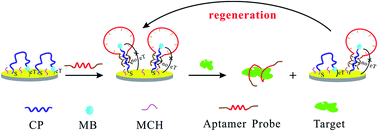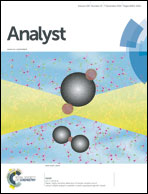A sensitive and versatile “signal-on” electrochemical aptasensor based on a triple-helix molecular switch†
Abstract
In the present study, a versatile “signal-on” electrochemical aptasensor based on a triple-helix molecular switch has been developed. An aptamer probe is designed to hybridize with the methylene blue (MB)-modified DNA capture probe immobilized on the gold electrode to form rigid triple-helix DNA, impeding the efficient electron transfer of MB to the electrode and resulting in the decreased oxidation peak current of MB. However, upon introduction of the perfectly matched target, for example, human α-thrombin (Tmb), the interaction between Tmb and the aptamer probe leads to the dissociation of the triple-helix DNA structure and thereby liberates the MB-modified end of the capture probe, allowing the MB to collide with the electrode surface and resulting in an increase of the oxidation peak currents of MB. Therefore, the sensitive signal-on detection of Tmb is realized, and the detection limit of Tmb is 0.12 nM. The proposed approach also demonstrates excellent regenerability, reproducibility and stability. Additionally, it also has the advantages of simplicity in design and easy operation. The success in the present biosensor provides a promising alternative to the electrochemical detection of a variety of analytes and may have potential applications in point-of-care testing and clinical diagnosis.


 Please wait while we load your content...
Please wait while we load your content...